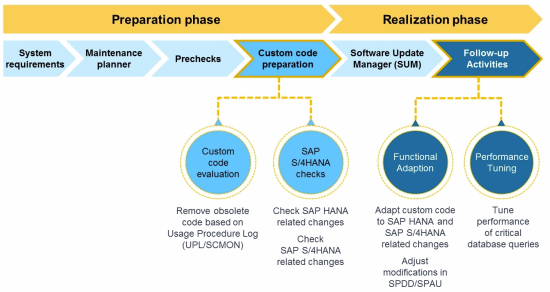Key elements while migrating to S4HANA
A short description of your blog post goes here
Here are some key differences between SAP ECC and SAP S/4HANA:
Push Code to Database: SAP S/4HANA introduces a new approach that shifts more code execution to the database layer. This requires the HANA database to be highly performant. To achieve this, SAP has changed the database model, now using a columnar data store instead of the traditional row-based storage. Additional features such as data compression and parallel processing further enhance performance.
Cluster Tables to Transparent Tables: Cluster tables have been replaced with transparent tables in SAP S/4HANA.
Implicit Sorting: Implicit sorting of query results is no longer supported in SAP S/4HANA.
Changes to Native SQL: Scripts using Native SQL with EXEC SQL must be updated to comply with the new standards.
No Direct Access to Cluster Tables: Direct access to cluster tables has been removed.
Simplifications in S/4HANA: SAP S/4HANA introduces a series of simplifications, which are documented in OSS Notes for each module. For example:
Transactions like MB01 are no longer available.
The length of the MATNR field has been increased from 18 to 40 characters. (In some cases, activating the new length is optional.)
Many other complex simplifications are detailed in the OSS Notes.
Document Status Tables: Tables like VBUP and VBUK (used for document statuses) have been removed. Status information is now embedded within document tables such as VBAK and LIKP. Any code that references VBUK or VBUP will need adjustments.
Tables Replaced by CDS Views:
Some tables, such as the large BSIS table, are now represented as CDS views for better performance. For example, the BSIS table is redirected to a CDS view, and it’s recommended to use the CDS view instead of the original table.
The MSEG table has been replaced by the CDS view NSDM_E_MSEG for SQL reads. The SAP server uses a central proxy to manage this redirection, with the proxy object referenced in the table.
If you had implemented an appended structure to BSIS, you need to define custom fields in a new view extension.
Write access is not redirected by the central proxy, so code modifications are required.
Note that some tables still exist but are not redirected.
SYCM Transaction: The SYCM transaction displays simplifications for a target release. You can visit SAP Launchpad for more details.
Potential Migration Issues: Common issues during migration to SAP HANA include:
The use of Native SQL in code.
Database Hints.
Code that assumes SELECT results are always sorted.
During the custom code preparation phase, developers can use transaction SCMON to identify obsolete and unused code. Further code adjustments related to S/4HANA object conversions—such as the replacement of certain tables—will be handled within the SPAU/SPDD transaction during functional adaptation. It is highly recommended to perform a readiness check before the conversion. For more details, refer to SAP Note 2436688. The simplification item-check will be carried out by the SUM (Software Update Manager) during the conversion process. It is strongly advised to perform this check beforehand to reduce the upgrade effort.


